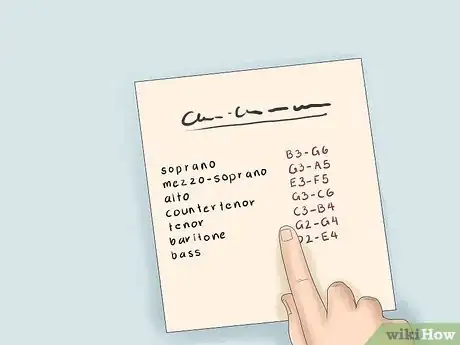This article was co-authored by Tanisha Hall. Tanisha Hall is a Vocal Coach and the Founder and Executive Director of White Hall Arts Academy, Inc. an organization based in Los Angeles, California that offers a multi-level curriculum focused on fundamental skills, technique, composition, theory, artistry, and performance at a conservatory level. Ms. Hall's current and previous students include Galimatias, Sanai Victoria, Ant Clemons, and Paloma Ford. She earned a BA in Music from the Berklee College of Music in 1998 and was a recipient of the Music Business Management Achievement Award.
There are 7 references cited in this article, which can be found at the bottom of the page.
This article has been viewed 61,683 times.
Singing in a subharmonic register, or 3:1 frequency, occurs when a singer's ventricular folds vibrate along with their vocal folds at the same time.[1] The effect produces a bass-heavy sound that is similar to Tuvan throat singing.[2] Vocal fry is a similar singing technique that also uses your lowest register, but requires less air to produce.[3] Singing in the subharmonic range can be difficult and feel unnatural, even to seasoned professionals. Luckily, finding your subharmonic register is possible if you follow the right techniques and continue to practice.
Steps
Finding Your Subharmonic Register
-
1Sing any note naturally. Sing a note that's comfortable and within your range. The starting note before you enter your subharmonic or lower vocal range is the note that you naturally speak at. Find the note that's in the middle of your register or the note that's closest to your speaking voice or chest voice. This will be a starting point before you go into your subharmonic or lower range.
- If you're unsure of your vocal range, read Find Your Vocal Range.
- Tenor range is in between C3 to B4.
- Baritone range is usually between G2 and a G4.
- Bass range is typically between D2 and an E4.
- Soprano range is typically between C4 and C6
- Mezzo-soprano range is typically between A3 and A5
- Alto range is typically between F3 to F5
-
2Slide the tone up and then down to the lowest note you can sing. Slide the note slightly a half-note up and then bring your singing voice all the way down to the lowest note you can comfortably sing. Sustain the lowest note you can without your voice cracking or popping.Advertisement
-
3Sing the note a fifth up from your lowest register. Bring your voice the fifth note from what you were singing. Play a piano note in tandem with your voice so that you can correctly raise the note a fifth. This is the note you'll be in when singing in your subharmonic range. This should also be one octave below your chest voice.[4]
- If your chest voice is an A2 note, your subharmonic tone should be in A1.
Adding Distortion
-
1Sustain a subharmonic note and purse your lips. Purse your lips so that your mouth is shaped like an oval as you sustain your subharmonic note. This will allow your subharmonic register to resonate better.[5]
-
2Push up from the back of your throat. Build up your subtone note until it feels comfortable to hold it. As the pressure builds into your torso, push out the note from the back of your throat. The goal is to sing with both sets of vocal cords to produce your subharmonic tone.
-
3Push down at the base of your tongue. Tighten and flatten your tongue near its base. Curl the tip of your tongue up slightly. This should distort the sound of your subharmonic tone.[6]
-
4Continue to hold the note. Keep practicing until it feels comfortable holding your subharmonic note. Continue to repeat the process until you can sing in your subharmonic tone.
Using Vocal Fry
-
1Practice vocal fry when you first wake up. When you first wake up, you may have a creaky or cracking voice. This is caused by slow and uneven vibration of your true vocal cords. This buzz or hum that is found in your voice is what vocal fry is. Practicing the technique when you first wake up is easier if you've never done it before.[7]
-
2Open your mouth and grumble. Use the least amount of air as you can to vocalize the grumble. This cracking sound is what it should sound like when you are doing vocal fry. Isolate your vocal cords, and try to increase the sound of this grumble. You should feel your vocal cords vibrate in your throat.[8]
-
3Adjust the pitch of your fry. Adjusting the pitch of the fry will help you control it. Try slowing down the tempo of your fry and using less and more air to create it. Continue to practice until you have control over it and can adjust it whenever you want to.[9]
Expert Interview

Thanks for reading our article! If you'd like to learn more about singing, check out our in-depth interview with Tanisha Hall.
References
- ↑ http://www.tandfonline.com/doi/full/10.3109/14015439.2016.1156737
- ↑ http://www.dailymail.co.uk/sciencetech/article-3548327/The-secret-Freddie-Mercury-s-incredible-singing-voice-revealed-Scientists-say-exceptional-vocal-control-turned-Queen-frontman-force-nature.html
- ↑ http://www.sciencemag.org/news/2011/12/vocal-fry-creeping-us-speech
- ↑ https://www.youtube.com/watch?v=I5-a1ikrY98&feature=youtu.be&t=3m13s
- ↑ http://www.voicescienceworks.org/extended-techniques.html
- ↑ http://www.voicescienceworks.org/extended-techniques.html
- ↑ https://theconversation.com/keep-an-eye-on-vocal-fry-its-all-about-power-status-and-gender-45883
- ↑ http://www.voicescienceworks.org/extended-techniques.html
- ↑ http://anyonecansing.org/can-anyone-learn-to-sing/tag/subharmonics/





































































